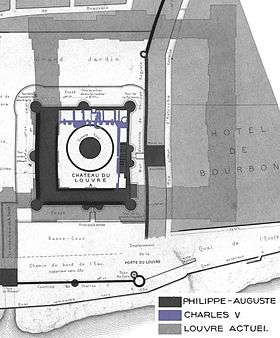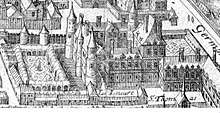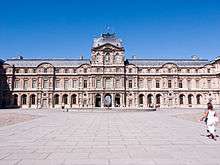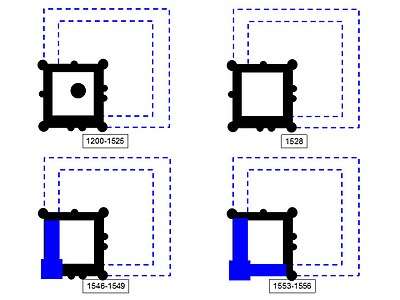Cour Carrée
The Cour Carrée is one of the main courtyards of the Louvre Palace in Paris. It was gradually built as the medieval Louvre castle was progressively demolished in favour of a Renaissance palace.
The steps of a progressive construction
Source of the whole paragraph :[1]

From 1190 to 1215, Philip-Augustus built the wall that bears his name around Paris to protect the capital from the English. To reinforce this enclosure on the western side, he built the Louvre castle, an important fortress with four high walls protected by a moat, towers, and a dungeon.
At the time of King Charles V of France (1364-1380), with its population increasing, Paris spread widely beyond the walls of Philip-Augustus. The king built a new enclosure which encompassed these new quarters, and the Louvre castle is now inside this new enclosure. Therefore, the castle loses much of its military interest. The king transformed the castle to make it more comfortable with the installation of numerous windows, the addition of chimneys, statues and turrets, and gardens.
After his return from a two-year captivity in Italy and Spain because of the defeat of Pavia (1524), King Francis I of France wanted to transform the old castle of the Louvre into a Renaissance style palace like those he experienced during his captivity. In 1528, he ordered the destruction of the "Grosse Tour" (big tower), which used to serve as the keep. This was done in four months and the area was occupied with his moat, serving the main part of the court of the castle. In 1546, the King asked architect Pierre Lescot and sculptor Jean Goujon to further undertake the castle's transformation.
After Francis I's death, his son Henri II (1547-1559) continued his work. He oversaw the destruction of the west wall to be rebuilt as a Renaissance palace of the same length from December 1546 to March 1549. This area is the current Lescot Wing. It hosted the "hall of the guards", today "salle des caryatides" which is a room for parties and also serves as a ballroom. Many historical events occurred in this room, such as the marriage of King Henri IV, an episode of the St. Bartholomew's Day massacre, the funeral wake of Henry IV, and Molière's first performance for King Louis XIV on October 16, 1658.

Henry II then destroyed and rebuilt the southern wall (1553-1556) to pave the way for the creation of the king's pavilion. At this stage, the building is very heterogeneous since two sides are Renaissance-style palaces and the other two remain those of the medieval castle with walls, battlements, and towers.
Queen Catherine de' Medici favoured the construction of her Tuileries Palace while Henry IV wanted his "gallery along the river", that is to say the link between the Louvre and the Tuileries. His plan was to quadruple the size of the courtyard of the Louvre castle with the extension of the buildings already built.

It was Louis XIII who destroyed the north wall of the castle (1624). The Lescot Wing was built for a court with the size of the one of the castle. It was not easy to integrate it into a courtyard whose sides would be twice as long. The idea of the new architect Jacques Lemercier is to duplicate this wing to the north: it will be the present Lemercier Wing (1636). And to install a pavilion between the two: the Pavillon de l'Horloge, today known as Pavillon Sully.
Louis XIV had the east wall demolished and renovated by architect Louis Le Vau. The last two walls to be demolished (north and east) were simply razed and the ditches filled. Their foundations remained intact. This is what made it possible to rediscover them in the nineteenth century (1866) and to update their base during the works of the Grand Louvre: it is the current collection of the Medieval Louvre.
Louis XIV doubled the length of the south wing and built the north wing. Three of the sides of the square yard are then in place. It remains to build the east wing which is important because it faces the city whose houses and buildings are close. It must be the new main entrance to the Louvre. After a contest launched by Jean-Baptiste Colbert, the king decides the construction of the Perrault's Colonnade on the east side outside [1665] by Claude Perrault and Louis le Vau . The work drags on because it is necessary to buy the land and the houses before the future colonnade to clear the view (the king does not have the power of expropriation). Moreover, the king privileges the Palace of Versailles from 1674.
Louis XIV also decided to double the width of the south wing (1670). This is why today we have two series of rooms : on the side of the courtyard side, the rooms of the Charles X museum ; on the side of the river Seine, the rooms of the Campana gallery with essentially Greek potteries. But this work of the south wing will not be completed until a century later.
After the departure of the royal court for Versailles, the unfinished buildings hosted artists. Heterogeneous constructions transpired in the courtyard.
After the abandonment and degradation of the Revolution, Louis XVIII restored the Louvre and placed his monogram on the three exterior facades of the cour Carrée (including the colonnade), with his monogram (two L's of stick characters turning their backs) whereas he only restored them.
- The transformation steps :


Description

The buildings form a square of about 160 meters on each side. They are articulated on eight Wings that punctuate eight Pavilions from northwest to west
- the pavillon de Beauvais ;
- the pavillon de Marengo, to the north;
- the pavillon nord-est ;
- the pavillon central (or pavillon Saint-Germain l'Auxerrois ), to the east, bordered on the outside by the Colonnade ;
- the pavillon sud-est ;
- the pavillon des Arts, au sud ;
- the pavillon du Roi (=King's Pavilion) ;
- the pavillon Sully (formerly known as pavillon de l'Horloge), to the west, recognizable by its clock, its four groups of monumental caryatids, its friezes of children and its high domed roof, the prototype of all the domes of the Louvre, in harmony sought after by successive architects.
On either side of the Sully pavilion there are:
- The Lescot Wing, built from 1546 to 1558, up to the King's Pavilion on the left.
- The Lemercier Wing, built in 1639, up to the pavilion de Beauvais on the right.
At the center of the Cour Carrée, there is a fountain.

Although the buildings were built over a period of 250 years, they show great homogeneity. The ground floor and the two storeys have successions of windows, bas-reliefs, statues in niches. The sovereigns wanted to leave their monograms on the parts they built. Those by Henri II, Charles IX, Henri IV, Louis XIII and Louis XIV can easily be identified and they help track the history of construction.
The Republic did not want to be outdone and installed a rooster in the fronton of the central wing of the east wing.
Example of sculptures

All the reliefs and statues of the cour carrée courtyard represent specific allegories or figures.
Here is the example of the first window on the left of the 2nd floor of the wing Lemercier, so close to the pavillon de l'Horloge. Above the window, an allegory of the Law. Then, at the level of the window from left to right: Moses with the tables of the law, the Egyptian goddess Isis with a sister, the Inca emperor Manco Cápac with the sun whose he is the son, Numa Pompilius the second king of the Roman monarchy.
References
- ↑ DVD les batailles du Louvre (=the battles of the Louvre) episode 1/2 www.artevod.com ARTE-615337
External links
| Wikimedia Commons has media related to Cour Carrée (Louvre). |
- http://www.francebalade.com/paris/louvre.htm (in English) (in French)
- Ministry of Culture photos (in French)
- A virtual visit of the Louvre (in English)
- Panoramic view of the pyramid and the Cour Napoléon (in French)
Coordinates: 48°51′37″N 2°20′19″E / 48.860399°N 2.338644°E